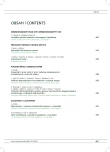The Use of the BOLD Effect when Examining Cerebrovascular Reserve Capacity
Authors:
A. Zolal 1; M. Sameš 1; P. Vachata 1; R. Bartoš 1; M. Nováková 2; R. Kopáček 3; M. Derner 2
Authors‘ workplace:
Krajská zdravotní, a. s., Masarykova nemocnice v Ústí nad Labem, o. z.
Neurochirurgická klinika UJEP
1; Krajská zdravotní, a. s., Masarykova nemocnice v Ústí nad Labem, o. z.
Radiodiagnostické oddělení
2; Krajská zdravotní, a. s., Masarykova nemocnice v Ústí nad Labem, o. z.
Oddělení nukleární medicíny
3
Published in:
Cesk Slov Neurol N 2009; 72/105(5): 476-480
Category:
Short Communication
Overview
Aim:
To describe the method of cerebrovascular reserve capacity (CVRC) examinati on with the use of a BOLD (blo od oxygenati on level dependent) effect and to present the comparison of the obtained results with the results of SPECT as a standard method.
Pati ents and methods:
This paper describes a gro up of seven pati ents with unilateral internal carotid occlusi on, who underwent CVRC examinati on with BOLD MRI and 99mTc- HMPAO SPECT. The obtained data were preprocessed and two regi ons of interest (ROI) were defined in the perfusi on territory of the middle cerebral artery and in the watershed supraventricular white matter. The results of both examinati ons were a utomatically extracted using these two ROIs, allowing statistical comparison.
Results:
In this gro up of pati ents, a statistically significant (p < 0.01) Pe arson correlati on coeffici ent of 0.716 was fo und for the whole gro up of ROIs (2 ROIs per pati ent). The images resulting from both examinati ons also demonstrate go od correlati on between the two methods, even on visu al inspecti on.
Conclusi on:
The results of CVRC examinati on using BOLD effect correlate well with the results of SPECT. The work confirms the experi ence described in the small number of available internati onal publicati ons, more over, it provides the re ader with a descripti on of a simple, clinically well fe asible methodology of this relatively new CVRC examinati on method.
Sources
1. Herzig R, Hlustik P, Skolo udik D, Sanak D, Vlachova I,Herman M et al. Assessment of the cerebral vasomotor re activity in internal carotid artery occlusi on using a transcrani al Doppler sonography and functi onal MRI. J Ne uro imaging 2008; 18(1): 38– 45.
2. Knop J, Thi e A, Fuchs C, Si epmann G, Ze umer H. 99mTc- HMPAO- SPECT with acetazolamide challenge to detect hemodynamic compromise in occlusive cerebrovascular dise ase. Stroke 1992; 23(12): 1733– 1742.
3. Mandell DM, Han JS, Po ublanc J, Crawley AP, Stainsby JA, Fisher JA et al. Mapping cerebrovascular re activity using blo od oxygen level- dependent MRI in Pati ents with arteri al steno‑occlusive dise ase: comparison with arteri al spin labeling MRI. Stroke 2008; 39(7): 2021– 2028.
4. Derdeyn CP, Grubb RL Jr, Powers WJ. Indicati ons for cerebral revascularizati on for pati ents with atherosclerotic carotid occlusi on. Skull Base 2005; 15(1): 7– 14.
5. Ziyeh S, Rick J, Reinhard M, Hetzel A, Mader I, Speck O.Blo od oxygen level- dependent MRI of cerebral CO2 re activity in severe carotid stenosis and occlusi on. Stroke 2005; 36(4): 751– 756.
6. Lythgoe DJ, Willi ams SC, Cullinane M, Markus HS. Mapping of cerebrovascular re activity using BOLD magnetic resonance imaging. Magn Reson Imaging 1999; 17(4): 495– 502.
7. van der Zande FH, Hofman PA, Backes WH. Mapping hypercapni a‑induced cerebrovascular re activity using BOLD MRI. Ne uroradi ology 2005; 47(2): 114– 120.
8. Podreka I, Suess E, Goldenberg G, Steiner M, Brücke T, Müller C et al. Initi al experi ence with techneti um- 99m HM- PAO brain SPECT. J Nucl Med 1987; 28(11): 1657– 1666.
9. Shiino A, Morita Y, Tsuji A, Maeda K, Ito R, Furukawa A et al. Estimati on of cerebral perfusi on reserve by blo od oxygenati on level- dependent imaging: comparison with single‑photon emissi on computed tomography. J Cereb Blo od Flow Metab 2003; 23(1): 121– 135.
Labels
Paediatric neurology Neurosurgery NeurologyArticle was published in
Czech and Slovak Neurology and Neurosurgery

2009 Issue 5
- Metamizole vs. Tramadol in Postoperative Analgesia
- Metamizole at a Glance and in Practice – Effective Non-Opioid Analgesic for All Ages
- Memantine in Dementia Therapy – Current Findings and Possible Future Applications
- Memantine Eases Daily Life for Patients and Caregivers
- Hope Awakens with Early Diagnosis of Parkinson's Disease Based on Skin Odor
Most read in this issue
- Lumbar Spinal Stenosis and Neurogenic Claudicati on
- Dissoci ative Seizures
- Indication of Decompressive Craniectomy in Traumatic Brain Injury
- The Genetics of Parkinson’s Disease
